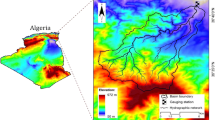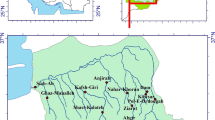Abstract
Estimations of annual suspended sediment loads are required for various types of water resources studies. Often estimation of the sediment load is needed for ungauged watersheds. Regionalization methods provide a practical solution to solve such problems. The purpose of this study is to classify suspended sediment yields in watersheds into homogeneous regions in order to identify their regional sediment rating curves. This study has been carried out for suspended sediment stations on 26 main basins of Turkey. Long term-scale suspended sediment rating curves of 115 gauging stations in Turkey were classified using cluster analysis on the basis of hydrological homogeneity. An agglomerative hierarchical clustering algorithm is used so that stations from different geographical locations are considered in the same cluster independently of their geographical location. 115 gauging stations were clustered into 4 different homogenous regions and the regional suspended sediment rating curve was developed for each region. The performance efficiencies of the developed regional rating curves were evaluated for 8 test stations and compared to the performances of rating curves in test sites. A regionalization model is developed for estimating suspended sediment rating curves for ungauged sites in Turkey. The developed regional rating curve models result in very close performances to those of their corresponding site rating curves.






Similar content being viewed by others
References
ARIS (2013a) Turkey Erosion risk map, Available at http://aris.ormansu.gov.tr/erz/. Accessed 5 March 2013
ARIS (2013b) Land cover map, available at http://aris.ormansu.gov.tr/crn/. Accessed 5 March 2013
Asselman NEM (2000) Fitting and interpretation of sediment rating curves. J Hydrol 234:228–248
Balat H (2007) A renewable perspective for sustainable energy development in Turkey: the case of small hydropower plants. Renew Sust Energ Rev 11:324–346
Bishwakarma MB, Stole H (2008) Real-time sediment monitoring in hydropower plants. J Hydr Res 46(2):282–288
Bray DI, Xie H (1993) A regression method for estimating suspended sediment yields for ungauged watersheds in Atlantic Canada. Can J Civil Eng 20:82–87
Burn DH, Zrinji Z, Kowalchulk M (1997) Regionalization of catchments for regional flood frequency analysis. J Hydrol Eng 2(2):76–82
Chen Z, Li J, Shen H, Wang Z (2001) Yangtze River of China: historical analysis of discharge variability and sediment flux. Geomorphology 41:77–91
Cohn TA, Caulder DL, Gilroy EJ, Zynjuk LD, Summers RM (1992) The validity of a simple statistical model for estimating fluvial constituent loads: an empirical study involving nutrient loads entering Chesapeake Bay. Water Resour Res 28:2353–2363
De Boer DH (1997) Changing contribution of suspended sediment sources in small basins resulting from European settlement on the Canadian prairies. Earth Surf Proc Land 22:623–639
DSI (2000) Monthly mean flows of Turkey rivers. DSI, Ankara
EIE (2003) Suspended sediment measurements and transport rates in Turkey rivers. EIE, Ankara
Everitt B, Landa S, Leese M (2001) Cluster analysis. Arnold, London
Fenn CR, Gurnell AM, Beecroft IR (1985) An evaluation of the use of suspended sediment rating curves for the prediction of suspended sediment concentration in a proglacial stream. Geogr Ann A 67A(1–2):71–82
Ferguson RI (1986) River loads underestimated by rating curves. Water Resour Res 22:74–76
Ferguson RI (1987) Accuracy and precision of methods for estimating river loads. Earth Surf Proc Land 12:95–104
Francke T, Lopez-Tarazon JA, Schroder B (2008) Estimation of suspended sediment concentration and yield using linear models, random forests and quantile regression forests. Hydrol Process 22:4892–4904
Horowitz AJ (1995) The use of suspended sediment and associated trace elements in water quality studies. IAHS Special Publication 4. IAHS Press, Wallingford
Horowitz AJ (2003) An evaluation of sediment rating curves for estimating suspended sediment concentrations for subsequent flux calculations. Hydrol Process 17:3387–3409. doi:10.1002/hyp.1299
Horowitz AJ, Elrick KA, Smith JJ (2001) Estimating suspended sediment and trace element fluxes in large river basins: methodological considerations as applied to the NASQAN programme. Hydrol Process 15:1107–1132
Hu B, Wang H, Yang Z, Sun X (2011) Temporal and spatial variations of sediment rating curves in the Changjiang (Yangtze River) basin and their implications. Quatern Int 230:34–43
Isik S, Singh VP (2008) Hydrologic regionalization of watersheds in Turkey. J Hydrol Eng 13:824–834
Isik S, Dogan E, Kalin L, Sasal M, Agiralioglu N (2008) Effects of anthropogenic activities on the lower Sakarya river. Catena 75(2):172–181
Jansson M (1985) A comparison of detransformed logarithmic regressions and power function regressions. Geogr Ann A 67A:61–70
Jiongxin X (2004) A study of anthropogenic seasonal rivers in China. Catena 55:17–32
Kahya E, Demirel MC, Bég AO (2008) Hydrologic homogeneous regions using monthly streamflow in Turkey. Earth Sci Res J 12(2):181–193
Kalin L, Hantush MM (2006) Comparative assessment of two distributed watershed models with application to a small watershed. Hydrol Process 20(11):2285–2307
Koch RW, Smillie GM (1986) Bias in hydrologic prediction using Log-transformed regression models. Water Res Bull 22(5):717–723
Kuhnle RA, Bingner RL, Foster GR, Grissinger EH (1996) Effect of land use on sediment transport in Goodwin Creek. Water Resour Res 32:3189–3196
Lecce SA (2000) Spatial variations in the timing of annual floods in the southeastern United States. J Hydrol 235:151–169
MATLAB version 7.10.0 (2010) Computer software. The Math Works Inc., Natick
MGM (2013) Annual cumulative precipitation map, available at http://www.mgm.gov.tr/veridegerlendirme/aylik-normal-yagis-dagilimi.aspx?a=00#sfB. Accessed 5 March 2013
Milliman JD, Qin YS, Ren ME, Saito Y (1987) Man’s influence on the erosion and transport of sediment by Asian rivers: the Yellow River (Huanghe) example. J Geol 95:751–762
Morehead MD, Syvitski JP, Hutton EWH, Peckham SD (2003) Modeling the temporal variability in the flux of sediment from ungauged river basins. Glob Planet Change 39:95–110
Morgan RPC (1995) Soil erosion and conservation, 2nd edn. Longman, London
Mosley MP (1981) Delimitation of New Zealand hydrologic regions. J Hydrol 49:173–192
Nash JE, Sutcliffe JV (1970) River flow forecasting through conceptual models part I—a discussion of principles. J Hydrol 10(3):282–290. doi:10.1016/0022-1694%2870%2990255-6
Peart MR (1997) Human impact upon sediment in rivers: some examples from Hong Kong. In: Walling DE, Probst JL (eds) Human impact on erosion and sedimentation. IAHS, vol 245. IAHS Press, Wallingford, pp 111–118
Poulos SE, Collins M, Evans G (1996) Water-sediment fluxes of Greek rivers, southeastern Alpine Europe: annual yields, seasonal variability, delta formation and human impact. Z Geomorphol 40:243–261
Raux J, Copard Y, Laignel B, Fournier M, Masseï N (2011) Classification of worldwide drainage basins through the multivariate analysis of variables controlling their hydrosedimentary response. Glob Planet Change 79:117–127. doi:10.1016/j.gloplacha.2010.12.005
Rodgers M, O’Connor M, Robinson M, Muller M, Poole M, Xiao L (2011) Suspended solid yield from forest harvesting on upland blanket peat. Hydrol Process 25:207–216. doi:10.1002/hyp.7836
Singh KP, Durgunoglu A (1989) Developing accurate and reliable stream sediment yields, sediment and the environment, vol 184. IAHS, Wallingford, pp 193–199
Stahl K, Demuth S (1999) Methods of regional classification of stream flow drought series: cluster analysis, ARIDE Technical Report 1, Institute of Hydrology. University of Freiburg, Germany
Sutherland RA, Bryan RB (1991) Sediment budgeting: a case study in the Katiorin Drainage Basin, Kenya. Earth Surf Proc Land 16:383–398
Syvitski JP, Morehead MD, Bahr DB, Mulder T (2000) Estimating fluvial sediment transport: the rating parameters. Water Resour Res 36(9):2747–2760
Tiffen M, Mortimore M, Gichuki F (1994) More people, less erosion: environmental recovery in Kenya. Wiley, New York
Tramblay Y, Ouarda TBMJ, St-Hilaire A, Poulin J (2010) Regional estimation of extreme suspended sediment concentrations using watershed characteristics. J Hydrol 380:305–317
Unal Y, Kındap T, Karaca M (2003) Redefining the climate zones of Turkey using cluster analysis. Int J Climatol 23:1045–1055
Walling DE (1974) Suspended sediment and solute yields from a small catchment prior to urbanization. In: Gregory KJ, Walling’ DE (eds) Fluvial processes in instrumented watersheds, vol 6. Institute of British Geographers Special Publication, Institute of British Geographers, London, pp 169–192
Walling DE (1977) Assessing the accuracy of suspended sediment rating curves for a small basin. Water Resour Res 13:531–538
Walling DE (1990) Linking the field to the river: sediment delivery from agricultural land. In: Boardman J, Foster IDL, Dearing JA (eds) Soil erosion on agricultural land. Wiley, New York, pp 129–151
Walling DE, Webb BW (1981) The reliability of suspended sediment load data. In: Walling DE (ed) Erosion and sediment transport measurements, vol 133. IAHS Press, Wallingford, pp 177–194
Wang HJ, Yang ZS, Wang Y, Saito Y, Liu JP (2008) Reconstruction of sediment flux from the Changjiang (Yangtze River) to the sea since the 1860 s. J Hydrol 349:318–332
Williams GP (1989) Sediment concentration versus water discharge during single hydrologic events in rivers. J Hydrol 111:89–106
Willmot CJ (1981) On the validation of models. Phys Geogr 2:184–194
Wood P (1977) Controls of variation in suspended sediment concentration in the River Rother, West Sussex, England. Sedimentology 24:437–445
Yu PS, Yang TC, Liu CW (2002) A regional model of low flow for southern Taiwan. Hydrol Process 16:2017–2034
Author information
Authors and Affiliations
Corresponding author
Additional information
Communicated by: Hassan Babaie
Rights and permissions
About this article
Cite this article
Isik, S. Regional rating curve models of suspended sediment transport for Turkey. Earth Sci Inform 6, 87–98 (2013). https://doi.org/10.1007/s12145-013-0113-7
Received:
Accepted:
Published:
Issue Date:
DOI: https://doi.org/10.1007/s12145-013-0113-7




